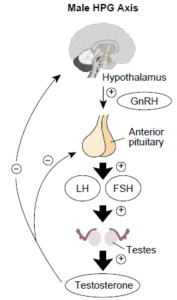There are so many important lab values related to testosterone deficiency (“Low T”) but doctors treating Low T are sometimes not checking all of them. Today, we’ll cover the essential lab tests you should ensure are being checked and why they’re necessary before and during Low T treatment.
We’ll refer to the hypothalamic-pituitary axis shown in the image below.

Luteinizing Hormone (“LH”)
The anterior pituitary gland produces LH to stimulate the Leydig cells in the testicles to produce the following androgens: testosterone, androstenedione and dehydroepiandrosterone (DHEA).
So you might be asking, “why don’t you just check for decreased testosterone levels”? It’s a great question but LH levels will help us determine the cause of low testosterone. If you have low testosterone, your anterior pituitary gland produces more LH so that you can get more testosterone.
If your LH is low-to-normal, while your testosterone is low, there is a central (or secondary) hypothalamic-pituitary defect. In other words, it means that the low testosterone is caused by the hypothalamus or pituitary gland rather than the testicles. This is referred to as “hypogonadotropic hypogonadism”.
In this case, we are able to treat low-T with clomiphene (Clomid ®) because this stimulates the pituitary to make more LH and, in turn, your testicles to create more testosterone. You may also choose injectable testosterone.
In contrast, an elevated LH level in the presence of low testosterone indicates a primary testicular defect called “hypergonadotropic hypogonadism”. This is easily treated with bio-identical testosterone injections or pellets.
Prolactin
If your LH level is low in the presence of low testosterone, we’ll also want to check your prolactin level. We’re checking for a condition called hyperprolactinemia (high prolactin). If prolactin is elevated, we’ll need to rule out a prolactinoma which is a tumor of the pituitary gland that produces prolactin. A high prolactin causes LH to be suppressed which leads to low testosterone.
Estradiol
Testosterone is aromatized to estradiol and it’s important to check the baseline estradiol before we start testosterone therapy. We will continue to check your estradiol level on follow-up visits. If the levels are increased and you are experiencing side effects related to estradiol, we will provide you with an aromatase inhibitor (anastrozole) to keep estradiol in check.
Hemoglobin/Hematocrit
The baseline hemoglobin and hematocrit prior to testosterone therapy is important to measure because testosterone may increase the level of red blood cells. While this is desired in patients with anemia, we’ll monitor this for supraphysiologic levels which can be treated by donating blood or decreasing testosterone dosage.
Prostate Specific Antigen (PSA)
This protein checks for prostate-related issues. An increased level indicates inflammation (prostatitis) or enlargement of the prostate (benign prostate hyperplasia; “BPH”). It can also indicate prostate cancer. It’s important to rule out prostate cancer because testosterone therapy needs to be discussed and a shared decision-making approach needs to be made with you and your treating physicians.
Total Testosterone
Total testosterone measures all of the testosterone in your blood. The issue with this test is that a significant portion of your testosterone is bound to proteins and, therefore, not free to use. Your free testosterone is always lower than your total testosterone. If you’re experiencing symptoms of low testosterone (such as low libido, reduced erectile function, low energy, poor concentration, reduced lean muscle mass), your total testosterone may be normal and it’s imperative to also check your free testosterone level.
In summary, make sure that you’re getting thorough lab values checked because it can affect your treatment protocol and avoid unwanted side effects. At Thrive Men’s Clinic, we check these values at our CLIA certified laboratory inside our office in Tarzana, CA and will have your results in as little as 20 minutes. This will ensure that you get the ideal treatment for low testosterone and without the delays associated with outside laboratories spread across Los Angeles and the San Fernando Valley
